Key Takeaways
1. Contagion is ubiquitous: From diseases to ideas, understanding spread is crucial
Outbreaks can come in many forms. They might involve things that bring harm – like malware, violence or financial crises – or benefits, like innovations and culture.
Contagion is everywhere. The principles that govern the spread of infectious diseases also apply to a wide range of phenomena, including:
- Financial crises and market bubbles
- Violence and crime
- Social behaviors and cultural trends
- Technological innovations
- Online content and misinformation
Understanding these dynamics is crucial for predicting, controlling, and harnessing contagion across various domains. By studying how things spread, we can develop strategies to:
- Prevent harmful outbreaks (e.g., epidemics, financial crashes)
- Promote beneficial contagion (e.g., positive social change, technological adoption)
- Identify key factors that influence transmission in different contexts
2. Network structure profoundly influences transmission dynamics
If you want an idea to spread, we ideally need people to be both highly susceptible and highly influential. But Aral and Walker found that such people were very rare.
Network topology matters. The structure of connections between individuals or entities in a network has a significant impact on how contagion spreads:
- Small-world networks: Combine local clustering with long-range connections, facilitating rapid spread across distant parts of the network
- Scale-free networks: Characterized by hubs with many connections, creating potential superspreaders
- Assortative vs. disassortative mixing: Determines whether high-degree nodes connect primarily to other high-degree nodes or to low-degree nodes
Key network properties affecting contagion:
- Degree distribution (number of connections per node)
- Clustering coefficient (tendency for nodes to form tightly connected groups)
- Path length (average number of steps between any two nodes)
- Centrality measures (identifying influential nodes)
Understanding network structure helps explain why some ideas, behaviors, or infections spread widely while others remain localized.
3. Superspreading events drive many outbreaks, not average transmission
Of the posts that spread, there was generally a single broadcast event behind its success.
Outliers drive contagion. Many outbreaks, whether of diseases, ideas, or behaviors, are characterized by superspreading events rather than consistent average transmission:
- The "20/80 rule": Often, 20% of individuals are responsible for 80% of transmission
- Examples of superspreading:
- Disease outbreaks: SARS, COVID-19
- Online content: Viral posts often driven by single high-profile shares
- Financial contagion: Failure of key institutions triggering widespread effects
Implications:
- Focusing solely on average transmission (R0) can be misleading
- Identifying and targeting potential superspreaders is crucial for control
- Highly variable transmission makes outbreaks less predictable and potentially more explosive
Understanding superspreading helps explain the "long tail" distribution observed in many contagion phenomena, from citation patterns to online content popularity.
4. Social behavior and context shape the spread of information and behaviors
The real promise of using data analytics to identify those at risk of gunshot victimization lies not with policing, but within a broader public health approach.
Context is key. The spread of information, behaviors, and even violence is heavily influenced by social factors and environmental context:
Social influences on contagion:
- Peer pressure and social norms
- Trust and credibility of information sources
- Cultural and community values
- Social reinforcement and complex contagion
Environmental factors:
- Physical proximity and interaction patterns
- Access to resources and technology
- Economic and political conditions
- Media landscape and information ecosystems
Case study: Violence as contagion
- Treating violence as a public health issue rather than purely a criminal justice problem
- Identifying at-risk individuals and intervening before violence occurs
- Addressing root causes and social determinants of violence
Understanding these contextual factors is crucial for designing effective interventions and predicting the spread of behaviors, ideas, and even harmful actions like violence.
5. Mathematical models provide powerful insights into outbreak patterns
We've already seen that for STIs, outbreaks generally follow the shape of a 'long-drawn-out letter S'.
Models illuminate patterns. Mathematical models of contagion provide valuable insights into outbreak dynamics and help predict future trends:
Key concepts in contagion modeling:
- Reproduction number (R0): Average number of secondary cases caused by one infected individual
- SEIR models: Tracking Susceptible, Exposed, Infected, and Recovered populations
- Network models: Incorporating contact structure into transmission dynamics
Applications of contagion models:
- Predicting epidemic curves and peak timing
- Evaluating the impact of interventions (e.g., vaccination, social distancing)
- Understanding threshold effects and tipping points
- Identifying key parameters driving outbreak dynamics
Limitations and challenges:
- Model assumptions and simplifications
- Data quality and availability
- Uncertainty in parameter estimates
- Behavioral changes and adaptive responses
Despite limitations, models remain essential tools for understanding and responding to various forms of contagion, from disease outbreaks to social phenomena.
6. Evolutionary processes affect both biological and cultural contagion
For genes like these, natural selection acts much faster in smaller populations: evolution happens rapidly in a place like the Galapagos Islands, for instance, or in a population of bacteria growing in a petri dish.
Evolution shapes spread. Both biological pathogens and cultural elements (ideas, behaviors, technologies) evolve as they spread, adapting to their environment:
Biological evolution in contagion:
- Pathogen mutations affecting transmissibility, virulence, and immune evasion
- Antibiotic resistance in bacteria
- Host-pathogen co-evolution
Cultural evolution:
- Meme adaptation and modification as they spread online
- Evolution of rumors and misinformation
- Technological innovations building on previous advances
Analogies between biological and cultural evolution:
- Selection pressures (e.g., attention economy for online content)
- Mutation and recombination of ideas
- Fitness landscapes and adaptive peaks
Understanding evolutionary dynamics helps explain:
- Why some variants become dominant during outbreaks
- How pathogens and ideas adapt to new environments
- The emergence of resistant strains or competing narratives
7. Data analysis revolutionizes our ability to track and predict outbreaks
As well as looking at how interest plateaus, we can also examine the early stages of adoption.
Big data transforms understanding. Advanced data analysis techniques and new data sources are revolutionizing our ability to track and predict various forms of contagion:
New data sources:
- Social media and online behavior
- Mobile phone and GPS data
- Genetic sequencing of pathogens
- Financial transaction records
Advanced analytical techniques:
- Machine learning and AI for pattern recognition
- Network analysis and graph theory
- Natural language processing for monitoring online discourse
- Phylogenetic analysis for tracing pathogen evolution
Applications:
- Real-time outbreak detection and monitoring
- Predicting the spread of misinformation
- Identifying emerging financial risks
- Tracking the adoption of new technologies or behaviors
Challenges:
- Data privacy and ethical concerns
- Integration of diverse data sources
- Dealing with biased or incomplete data
- Translating insights into actionable interventions
The data revolution offers unprecedented opportunities to understand and manage contagion, but also raises important ethical and practical challenges.
8. Ethical considerations are vital in studying and controlling contagion
Faced with a charge of attempted second-degree murder, Schmidt argued that the HIV virus that infected Trahan was too different to the original patient's virus; it just wasn't plausible that this had been the source of her infection.
Ethics are paramount. Studying and controlling contagion raises significant ethical concerns that must be carefully considered:
Key ethical issues:
- Privacy and data protection in tracking outbreaks
- Balancing individual rights with public health needs
- Equity in access to interventions and treatments
- Responsible use of predictive models and algorithms
Case studies in contagion ethics:
- HIV criminalization and disclosure laws
- Digital contact tracing during pandemics
- Ethical implications of gain-of-function research
- Balancing free speech with misinformation control
Ethical frameworks for contagion research and control:
- Informed consent and voluntary participation
- Minimizing harm and maximizing benefits
- Fairness and equitable distribution of risks/benefits
- Transparency and accountability in decision-making
Addressing ethical concerns is crucial for maintaining public trust and ensuring that efforts to understand and control contagion respect individual rights and societal values.
9. Interdisciplinary approaches yield novel insights into complex contagion
Researchers at the University of Pennsylvania have argued that rhyming might have had something to do with it.
Cross-pollination breeds innovation. Combining insights from diverse fields leads to novel understanding of complex contagion phenomena:
Interdisciplinary connections:
- Epidemiology and financial risk modeling
- Network science and social psychology
- Evolutionary biology and cultural studies
- Data science and public health
Examples of interdisciplinary insights:
- Applying epidemic models to understand financial crises
- Using network theory to analyze the spread of behaviors
- Adapting ecological concepts to study information ecosystems
- Leveraging machine learning for disease surveillance
Benefits of interdisciplinary approaches:
- Novel perspectives on longstanding problems
- Cross-fertilization of methods and tools
- Holistic understanding of complex systems
- Identification of unexpected parallels between domains
Challenges:
- Bridging different disciplinary languages and cultures
- Integrating diverse methodologies and data types
- Overcoming academic silos and funding structures
Embracing interdisciplinary approaches is essential for tackling the multifaceted challenges posed by various forms of contagion in our interconnected world.
10. Effective interventions target key transmission pathways
We can therefore use the reproduction number to work out how many people we need to vaccinate to control an infection.
Target critical pathways. Successful interventions to control or promote contagion focus on key transmission routes and leverage understanding of outbreak dynamics:
Strategies for controlling harmful contagion:
- Vaccination to reduce susceptible population
- Isolation and quarantine to limit contact opportunities
- Behavioral interventions to reduce transmission probability
- Environmental controls (e.g., improved sanitation, air filtration)
Approaches for promoting beneficial contagion:
- Identifying and leveraging influential nodes in networks
- Creating conditions for complex contagion through social reinforcement
- Designing sticky ideas that are memorable and shareable
- Reducing barriers to adoption of beneficial behaviors or technologies
Key principles for effective interventions:
- Focus on high-impact transmission pathways
- Tailor strategies to specific contagion dynamics
- Combine multiple complementary approaches
- Adapt interventions as outbreak evolves
Case studies of successful interventions:
- Ring vaccination strategy for smallpox eradication
- Social distancing and masking for COVID-19 control
- "Nudge" techniques for promoting healthy behaviors
- Viral marketing strategies for product adoption
Understanding key transmission pathways allows for targeted, efficient interventions that can dramatically alter the course of an outbreak, whether of disease, behavior, or ideas.
Last updated:
FAQ
What's The Rules of Contagion about?
- Exploration of contagion: The book examines why certain ideas, behaviors, and diseases spread while others do not, covering social behaviors, financial crises, and infectious diseases.
- Interconnectedness of outbreaks: Adam Kucharski highlights connections between seemingly unrelated phenomena, such as how financial crises can mirror disease outbreaks.
- Mathematical modeling: The author discusses using mathematical models to predict and analyze outbreaks, focusing on transmission dynamics like the reproduction number (R).
Why should I read The Rules of Contagion?
- Insightful connections: The book provides a unique perspective on contagion in various aspects of life, relevant for public health, sociology, and economics.
- Real-world applications: Kucharski's analysis offers practical insights for managing disease outbreaks and understanding social media trends.
- Engaging storytelling: The author uses compelling narratives and historical examples to make complex concepts accessible and engaging.
What are the key takeaways of The Rules of Contagion?
- Understanding contagion dynamics: Recognizing the stages of contagion, including spark, growth, peak, and decline, is crucial for various contexts.
- Role of social networks: Social connections significantly influence the spread of ideas and behaviors, with "small-world" networks being particularly relevant.
- Intervention strategies: Effective outbreak control involves targeted interventions and understanding the importance of timing.
What is the reproduction number (R) in The Rules of Contagion?
- Definition of R: The reproduction number (R) represents the average number of secondary infections produced by one infected individual in a fully susceptible population.
- Implications of R values: An R greater than one indicates likely spread, while an R less than one suggests the outbreak will decline.
- Factors influencing R: Duration of infectiousness, number of contacts, and transmission probability are key factors affecting R.
How does The Rules of Contagion relate contagion to financial crises?
- Financial contagion concept: The book draws parallels between infectious diseases and financial crises, describing how economic problems propagate through interconnected systems.
- Historical examples: Kucharski discusses crises like the 2008 financial meltdown to illustrate contagion's impact on economies.
- Mathematical modeling in finance: Models are used to analyze and predict financial contagion, identifying vulnerabilities in the financial system.
What is the concept of complex contagion in The Rules of Contagion?
- Multiple exposures needed: Complex contagion requires several interactions or exposures before behaviors or ideas are adopted.
- Social reinforcement: Social networks play a crucial role, where multiple friends engaging in an action increases adoption likelihood.
- Contrast with simple contagion: Unlike simple contagion, complex contagion relies on social context and repeated interactions.
How does The Rules of Contagion relate to public health?
- Epidemiological insights: The book parallels infectious disease spread with information dissemination, offering lessons for public health strategies.
- Behavioral interventions: Understanding contagion can inform strategies to increase vaccination rates and reduce misinformation spread.
- Case studies: Historical examples, like the smallpox vaccination campaign, illustrate applying contagion principles to improve health outcomes.
How does social media influence contagion according to The Rules of Contagion?
- Echo chambers: Social media can create echo chambers, reinforcing existing beliefs and affecting idea spread.
- Algorithmic impact: Algorithms determine content visibility, amplifying some messages while suppressing others, influencing public perception.
- Viral content dynamics: Understanding social media sharing mechanics is crucial for effective communication of important messages.
What are the stages of an outbreak as described in The Rules of Contagion?
- Four main stages: The stages are spark, growth, peak, and decline, each with distinct characteristics and implications.
- Importance of the spark: Identifying factors contributing to the initial spark helps predict future outbreaks.
- Multiple peaks: Some outbreaks, like the 2009 flu pandemic, may experience multiple peaks, informing public health responses.
What are some examples of contagion in behavior discussed in The Rules of Contagion?
- Obesity and smoking: Behaviors like obesity and smoking spread through social networks, influenced by friends and family.
- Emotional contagion: Emotions spread through social interactions, affecting group dynamics and individual well-being.
- Complex contagions: Some behaviors require multiple exposures, suggesting social reinforcement is necessary for spread.
How does The Rules of Contagion suggest we can control outbreaks?
- Targeted interventions: Understanding social networks and contagion dynamics allows for more effective resource allocation.
- Behavioral change: Changing social norms and behaviors through community engagement and education can reduce contagion spread.
- Monitoring and response: Continuous monitoring and rapid response to emerging cases are crucial for controlling contagion.
What future implications does The Rules of Contagion suggest for society?
- Need for adaptive strategies: Understanding contagion is crucial for addressing emerging challenges in an interconnected society.
- Importance of data literacy: Individuals and organizations need to become more data-literate to navigate information spread complexities.
- Potential for positive change: Applying contagion principles can harness social networks to promote beneficial behaviors and ideas.
Review Summary
The Rules of Contagion explores how diseases, ideas, and behaviors spread, applying epidemiological concepts to various fields. Readers appreciated the book's timely insights, especially regarding pandemics, and found the explanations of key concepts like R0 helpful. Many enjoyed the diverse examples and connections drawn between different types of contagion. However, some felt the book lacked cohesion and strayed too far from its core focus on diseases. Overall, reviewers found it informative and thought-provoking, despite occasional criticisms of its structure and depth.
Similar Books









Download PDF
Download EPUB
.epub digital book format is ideal for reading ebooks on phones, tablets, and e-readers.




